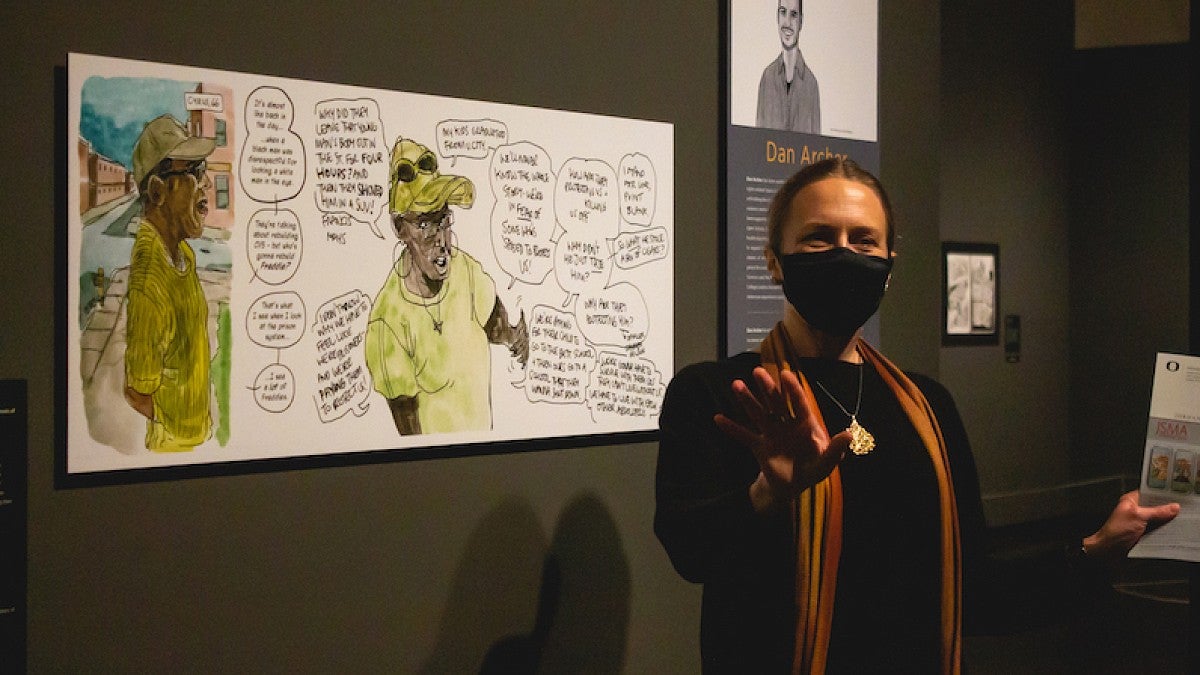Walk through “The Art of the News” exhibit at the Jordan Schnitzer Museum of Art and you’ll experience something that is much more than either comics or journalism, and yet it is grounded in both as it tells stories neither can on its own.
Subjects like the pandemic, war, social unrest, environmental change, prisons, sex trafficking and more are on display in the show, which runs through Jan. 16, 2022, and is the first major retrospective on 30 years of comics journalism. It exhibits original drawings, reproductions and digital works by 12 artists, prominently featuring one who many see as the trailblazer of the medium, 1981 UO journalism alumnus and New York Times bestselling author Joe Sacco.
Artists have been using the comic strip to report deeply human stories from their own perspectives for decades, said curator and assistant professor of English Katherine Kelp-Stebbins. She also is the associate director of the department’s comics and cartoon studies program.
“Comics journalism serves a really different purpose from what we might think of as more traditional news forms,” Kelp-Stebbins said. “It’s about taking time and care, and really leaning into the reporter’s experience; being clear about who you are and where you’re coming from, and making that a part of the story you’re telling and how you tell it.”
A free public symposium featuring several of the exhibited artists will be held at the museum Nov. 19-20 and will include panels, roundtables and gallery talks, plus a 90-minute dialogue and Q&A with Kelp-Stebbins and Sacco. Other symposium guests are Sarah Mirk, Gerardo Alba, Dan Archer, Tracy Chahwan, Jesús Cossio, Ben Passmore and Andy Warner. Also exhibited in the show are Thi Bui, Sarah Glidden, Omar Khouri, Victoria Lomasko and Yazan al-Saadi.
Comic journalists often dispense with the notion of ultimate objectivity. Many depict themselves as characters in their own stories to underscore that events are multidimensional and what they witness is inherently colored by their perspective.
“There’s a way that comics journalism is about not even breaking rules, but questioning what those rules give us or don’t give us when it comes to how journalism has been taught or understood,” Kelp-Stebbins said.
Because the labor-intensive medium is still establishing itself in subscription-based news media, many artists make a living publishing their work in books, selling original art and moonlighting as teachers, illustrators or infographic artists. But dedicated comics-journalism publications do exist around the world, and even close to home: Portland-based website The Nib offers newsletters and subscriptions.
Ink on paper isn’t the only work shown in the exhibit. Many artists’ work is digitized or native to digital media, and some of that work is displayed on touchscreens throughout the gallery. Comic artist Dan Archer has used virtual reality technology to create a space filled with people and mementos with which the viewer can interact. It’s part of a project called “Empathetic Media” that seeks to draw compassion for a subject by letting the viewer explore it as if they were actually experiencing it.
Comics journalism may be the closest thing to seeing through someone else’s eyes, artist Ben Passmore said. But it’s not always the eyes of the artist. When a story line requires the artist to depict someone’s perspective other than their own, it requires a lot of specific, visual questions, Sacco said, so he can bring the viewer into another person’s mind.
Most of the time, Sacco’s reporting work is carried out much like that of a traditional news reporter: His kit includes a recorder and a camera to capture reference shots for his drawings, and when he’s traveling internationally, he’s often accompanied by a fixer. He may use similar tools, but Sacco takes a slower approach.
“I know some cartoonists now who’ll go to a demonstration and draw, and post those drawings almost immediately. More power to them, but that’s not how I do my work,” Sacco said. “I’ve sort of leaned into the limitations of the medium, and one is that it takes a long time to draw something and put a book together. Mine was always a longer, slower form of journalism.”
Sacco likes how working in comics means there’s no real rulebook. As the field has grown up around him over the years, though, he jokes that the most exciting thing to observe has been his own ability to make a living.
For more information on the exhibit and symposium and to see video interviews with the artists created by UO students, visit the Jordan Schnitzer Museum of Art website.
–By Anna Glavash Miller, College of Arts and Sciences


